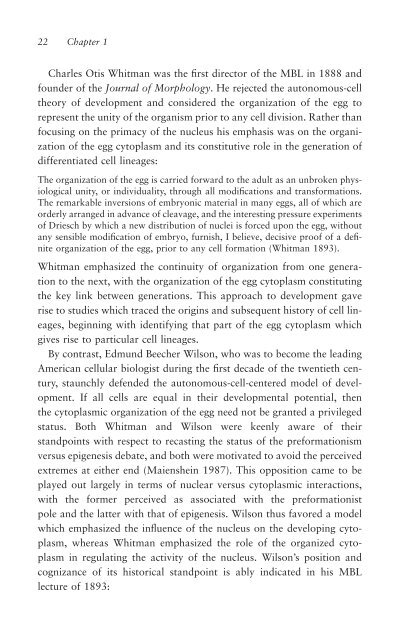A Critique of Pure (Genetic) Information
A Critique of Pure (Genetic) Information
A Critique of Pure (Genetic) Information
You also want an ePaper? Increase the reach of your titles
YUMPU automatically turns print PDFs into web optimized ePapers that Google loves.
22 Chapter 1<br />
Charles Otis Whitman was the first director <strong>of</strong> the MBL in 1888 and<br />
founder <strong>of</strong> the Journal <strong>of</strong> Morphology. He rejected the autonomous-cell<br />
theory <strong>of</strong> development and considered the organization <strong>of</strong> the egg to<br />
represent the unity <strong>of</strong> the organism prior to any cell division. Rather than<br />
focusing on the primacy <strong>of</strong> the nucleus his emphasis was on the organization<br />
<strong>of</strong> the egg cytoplasm and its constitutive role in the generation <strong>of</strong><br />
differentiated cell lineages:<br />
The organization <strong>of</strong> the egg is carried forward to the adult as an unbroken physiological<br />
unity, or individuality, through all modifications and transformations.<br />
The remarkable inversions <strong>of</strong> embryonic material in many eggs, all <strong>of</strong> which are<br />
orderly arranged in advance <strong>of</strong> cleavage, and the interesting pressure experiments<br />
<strong>of</strong> Driesch by which a new distribution <strong>of</strong> nuclei is forced upon the egg, without<br />
any sensible modification <strong>of</strong> embryo, furnish, I believe, decisive pro<strong>of</strong> <strong>of</strong> a definite<br />
organization <strong>of</strong> the egg, prior to any cell formation (Whitman 1893).<br />
Whitman emphasized the continuity <strong>of</strong> organization from one generation<br />
to the next, with the organization <strong>of</strong> the egg cytoplasm constituting<br />
the key link between generations. This approach to development gave<br />
rise to studies which traced the origins and subsequent history <strong>of</strong> cell lineages,<br />
beginning with identifying that part <strong>of</strong> the egg cytoplasm which<br />
gives rise to particular cell lineages.<br />
By contrast, Edmund Beecher Wilson, who was to become the leading<br />
American cellular biologist during the first decade <strong>of</strong> the twentieth century,<br />
staunchly defended the autonomous-cell-centered model <strong>of</strong> development.<br />
If all cells are equal in their developmental potential, then<br />
the cytoplasmic organization <strong>of</strong> the egg need not be granted a privileged<br />
status. Both Whitman and Wilson were keenly aware <strong>of</strong> their<br />
standpoints with respect to recasting the status <strong>of</strong> the preformationism<br />
versus epigenesis debate, and both were motivated to avoid the perceived<br />
extremes at either end (Maienshein 1987). This opposition came to be<br />
played out largely in terms <strong>of</strong> nuclear versus cytoplasmic interactions,<br />
with the former perceived as associated with the preformationist<br />
pole and the latter with that <strong>of</strong> epigenesis. Wilson thus favored a model<br />
which emphasized the influence <strong>of</strong> the nucleus on the developing cytoplasm,<br />
whereas Whitman emphasized the role <strong>of</strong> the organized cytoplasm<br />
in regulating the activity <strong>of</strong> the nucleus. Wilson’s position and<br />
cognizance <strong>of</strong> its historical standpoint is ably indicated in his MBL<br />
lecture <strong>of</strong> 1893:
















